One year and 12,593 inpatients later: U-M says care at new C.S. Mott Children's Hospital expanding quickly
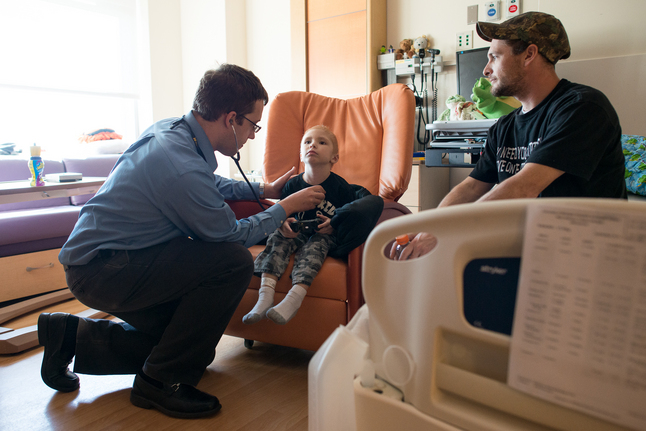
Leukemia patient Josh McCarthy Jr., 6, of Jackson, keeps his eyes glued to the television in his room at C.S. Mott Children's Hospital in Ann Arbor while Dr. Andy Prout checks his pulse and Josh's father, Josh McCarthy Sr., looks on. Josh is often in the hospital for weeks at a time for chemotherapy, and his family is able to stay with him in his private room.
Courtney Sacco I AnnArbor.com
The $754 million construction project broke records for the University of Michigan as the largest in the school’s history, and it was the largest in the state.
Five years in the making, the new 1.1 million-square-foot facility doubled the size of the old building and also distinguished itself with obtaining LEED certification. The new children's hospital also houses the Von Voigtlander Women's Hospital on the ninth floor.
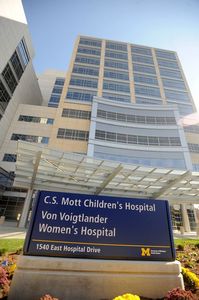
The main entrance of the new C.S. Mott Children's Hospital and Von Voigtlander Children's Hospital in Ann Arbor.
Angela J. Cesere | AnnArbor.com
As the financial state of the entire U-M Health System relies on Mott hitting targeted goals, hospital officials state they're encouraged by the new facility sparking gains in patient care that are greater than they had planned for.
“I’m feeling better than I thought I would,” said Dr. Chris Dickinson, interim executive director of Mott and a pediatric gastroenterologist. “We had a plan for activity. Whenever you open a new building, they’re not profitable immediately. So you need to ramp up the business. We’re ahead of what we had planned for activity.”
After the opening of the new Mott Dec. 4, 2011, the facility has experienced marked gains in births, discharges, emergency room capabilities, and according to internal surveys, patient satisfaction is rising.
The investment
Barriers for growth for the University of Michigan Health System are a rotating matrix of bed capacity, staffing levels and patient demand, said Doug Strong, CEO of UMHS.
“In order to make it work we need the physical capabilities: Beds, (operating rooms), clinics, exam rooms, you need the physicians and the nurses, and then you need the patients: you really need them all. At one time or the other, one can be more of a problem than the other," Strong said. "Historically our beds and our (operating rooms) have been the major constraint that we have had to deal with because our business has continued to grow."
For the old children's hospital at U-M, the 200-bed facility was at capacity. The old Mott was more than 40 years old and was not built to handle the growing technological advancements of modern health care.
The new $754 million Mott facility is funded by the entire health system, which means UMHS has to pay back $588 million in debt from tax-exempt bonds over a 30-year time frame.
About $91 million in cash reserves stockpiled from health system operations and $75 million garnered through fundraising funded the remainder of construction.
Administrators knew the opening of the new facility would set the health system back, and initially projected that it meant they would be operating at a 1.1 percent operating loss for the 2012 fiscal year.
At the end of June upon the ending of the 2012 fiscal year, health system officials announced that they were over their $2.25 billion budgeted expenses by $11.3 million -- a margin that was better than expected, meaning an operating loss of 0.5 percent.
The health system is expected to pull out of the red and into the black in 2013: The fiscal year 2013 adopted budget has a 0.5 percent positive operating margin built in, with $2.39 billion in projected revenue and $2.379 billion in expenses.
Start-up costs for the new Mott totaled near $70 million, but the expansion of space for pediatric and women's specialty services are picking up some slack: Revenue per patient case between December 2011 and October 2012 is up 12.9 percent from the previous year.
In fiscal 2011, the average cost per case at the old Mott was $21,830.
Hospital administrators attribute this rise in revenue per case to the new pediatric emergency room space in Mott, as well as increased operating room capacity and admissions for specialized treatment.
With the opening of the first separate pediatric emergency department at UMHS in the new Mott in a space that's tripled from the space they previously occupied, staff has been able to treat 10 percent more pediatric patients in 2012 than in 2011.
The adult emergency department also has been able to expand its treatment capabilities by about 9 percent in the past year, as the pediatric emergency department vacated 11 rooms in University Hospital.
The Michigan market
C.S. Mott Children's Hospital and the Children's Hospital of Michigan, run by the Detroit Medical Center, are the only two hospitals in the state with programs to train pediatric emergency physicians.
The two hospitals are also competitors in other measures. With the opening of the new Mott, the hospitals are nearly tied for the status of the biggest neonatal emergency care unit in the state.
There are 41 beds in Mott's neonatal intensive care unit (NICU) to 45 beds in the NICU at the Children's Hospital of Michigan. However, UMHS has applied for licensing of five additional beds in its NICU -- which, if approved, would make Mott's the biggest neonatal intensive care unit in the state.
However, the construction of the new Mott has surpassed Children's Hospital of Michigan in licensed beds overall. The Detroit facility has 228 beds, while the new Mott is currently using 270 out of 348 possible beds in its building.
With the construction of the new Mott, the University of Michigan Health System now has the third-highest number of beds of any Michigan hospital with a total of 925.
Encompassing nine hospitals in metro Detroit, the Detroit Medical Center has more than 2,000 beds and the most out of any health system in the state. Next is William Beaumont Hospital in Royal Oak with 1,040 beds.
However competing for metro Detroit patient's isn't the primary focus for UMHS, Strong said.
Consistently across the state -- even into the Upper Peninsula -- UMHS has between 5 and 7 percent market share of pediatric patients, Strong said.
“What that means is our physicians recognize for that small percent, that we’re that place to send the patients,” he said.
Overall, two-thirds of the patients at UMHS are there because their physicians have referred them to to the health system for the highly specialized care that the hospitals offer, Strong said.
The expansion of specialty services with the construction of the new Mott is important for UMHS to build on its reputation for highly complex care to grow relationships with physicians across Michigan for referral cases.
“We invest in patient care, we invest in research and we invest in education,” Strong said. “Every one of those feeds off each other. And so if we want our research part of our business to continue to increase -- which we do -- we have to increase our patient care activity. It all links together.”
Design for patients, present and future
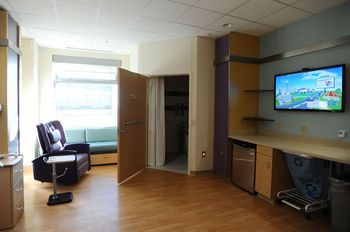
A view of Ann Arbor can be seen from a patient room on the 11th floor in C.S. Mott Children's Hospital.
Melanie Maxwell I AnnArbor.com
“I was concerned that when we were going to these bigger rooms, that our staff would be more spread out, and that the kind of communication we used to have … that piece would be a bigger problem than it’s turned out to be,” Dickinson said.
The private rooms also mean that the pediatric patients and their families are sleeping more, Dickinson said, which has drastically changed the interactions between the patients and the doctors in a positive way.
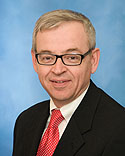
Dr. Chris Dickinson
Courtesy U-M
“I worried about the big spaces,” Dickinson said. “For our nursing staff that were a little ‘long in the tooth’ like me, would that extra walking be a problem for them? They’ve actually said no, especially on nights, because our patients actually sleep now … Although there’s more walking, there’s less stress.”
Patient satisfaction surveys are up by statistically significant margins, said Loree Collett, associate hospital director at Mott.
Hospital officials are especially excited about the presence of a flat-screen television in each patient room that allows patients and their families to play games, watch movies and order food.
The spread-out design also means nursing stations have been decentralized and nurses can do charts from alcoves outside a patient’s room that is next to a window into the patient’s room.
“From a nursing perspective, what we’ve offered staff the opportunity to do that we never really had in the old building was to be physically seen sitting outside of a patient room,” Collett said.
Nurses can now observe patients without having to walk into a room, which contributes to the amount that patients sleep, Dickinson said.
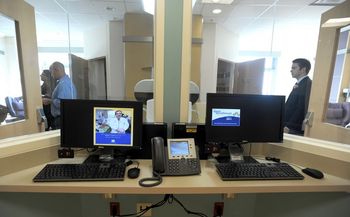
A nurses' station from which patients can be monitored in their rooms on the 11th floor of C.S. Mott Children's Hospital in Ann Arbor.
Angela J. Cesere | AnnArbor.com
The new Mott has a 50-year lifespan and was built to accommodate any new developments in technology that may arise.
The facility has a capability for 348 beds, but currently has 270 in use. The old hospital had about 200 beds and was at full capacity.
The latent beds not in use at the facility are spread throughout various departments. In the pediatric and neonatal intensive care units, about 20 beds can be opened, Dickinson. A 32-bed general care unit is also not in use.
Each patient room in the facility is a minimum of 300 square feet large, with the exception of the neonatal intensive care units that are 200 square feet large. Conference rooms and office spaces were built to be ready for a switch to a patient room.
To staff the expansion in the new facility, nearly 500 employees were hired to assist the 4,000 workers making the transition.
“We spent a lot of time on this, getting the crystal ball out, thinking about how would technology change, what would it look like,” Dickinson said. “The real question is, what does that look like 20 years from now, and will this building work for it?”
Room for growth has been built intrinsically into each department of the new facility, as there are some undeveloped spaces in the operating rooms and in the radiology department.
“The building is good for the forseeable future, which is my crystal ball for the next decade, but after that I don’t know,” Dickinson said. “We tried to create flexibility in the building.”
Departmental shifts
The design of the new building integrates many departments that were previously in separate parts of the health system, a risk that health system officials said has turned out well.
Witness to the change is Dr. Richard Ohye, head of the pediatric cardiovascular surgery division at Mott.
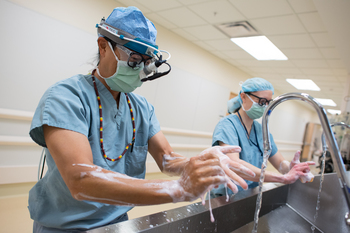
Dr. Richard Ohye and surgery fellow Dr. Jennifer Nelson scrub up outside the operating room before a surgery at C.S. Mott Children's Hospital in Ann Arbor.
Courtney Sacco I AnnArbor.com
“The increased contact increases our ability to work together,” Ohye said. “To have all our faculty together … has been tremendous.”
Ohye said it's common for physicians to conference together in the new hospital to discuss how to treat some pediatric patients with complicated diseases.
“It’s not black and white,”Ohye said, describing how treatment solutions for some sick children aren’t cut and dry. “Usually there’s not one answer to some of these complex kids.”
For a department like cardiovascular surgery, the new space in Mott is vital given the advances in technology that have propelled the forms of treatment in a new direction. Even into the 1980s and 90s, there were some heart lesions that were extremely high risk to treat or didn’t have a course of treatment at all, Ohye said.
“In the 2000s, we’re finally at a point where we can treat almost every lesion with equal success,” Ohye said. “We’ve come a long way in a short period of time.”
About 10 percent of the department’s patients are newborn and 40 percent are less than one year old, Ohye said.
“We’re definitely working more efficiently, as it pertains to the (intensive care unit),” Ohye said. “Our volume is up in the operating room, but the number of patients in the ICU is down because we’re getting them through more quickly.”
There are several reasons Ohye said children are able to leave the ICU quicker - but the main reason Ohye sees is the increased number of beds on the floor and the ability for each patient to have their own space.
“From my program, we draw from kids from 43 and 17 countries because we always drew the sickest of the sick from around the country and around the world,” Ohye said. “The (new) hospital hasn’t changed that, it’s made it easier.”
Staff adjustments
Hospital staff had to adjust to the different layout of the facility and location of medical supplies and various labs after all patients moved from the old building to the new one in 12 hours Dec. 4, 2011. It took about half a year for nurses and doctors to truly feel at home after the move, Collett said.
“Over the course of those first three to four months, it was just getting familiar with the building,” Collett said. “And then we really had a tipping point where staff were saying, ‘I love the new building. I love the new space. My patients are happier, the families are happier. I know how to get around.’”
The health system also made a large financial investment in phones for each nurse as a secondary alert notification system, which sends notices when a patient’s vital signs reach certain critical thresholds.
The phone alert system has meant quicker response times to patient rooms when there's a problem, Dickinson said.
Administrators were in talks this fall to evaluate if their hiring plans established years before the hospital opened had worked.
“We’ve had a lot of discussions about (staffing) recently, and I would say we’re pretty darn close to a sweet spot,” Dickinson said. “We may be a tad over, but we’re coming in to the flu season, and that means lots of patients, so we’re right about where we want to be.”
Amy Biolchini covers Washtenaw County, health and environmental issues for AnnArbor.com. Reach her at (734) 623-2552, amybiolchini@annarbor.com or on Twitter.


Comments
15crown00
Mon, Dec 3, 2012 : 5:39 a.m.
A much needed facility.Glad it's working out well.
Liz
Sun, Dec 2, 2012 : 8:24 p.m.
I was dismayed to read the quote attributed to Dr. Dickinson..."I worried about the big spaces...For our nursing staff that were a little "long in the tooth"...would that extra walking be a problem for them" He is comforted by the illusion that patients sleep more, and that lessens stress. Many of these "long in the tooth nurses" are staffing the Intensive Care Units, where the clock runs 24 hours a day. And they bring to those "big spaces" countless years of experience, at least as valuable as picture windows.
dugster
Sun, Dec 2, 2012 : 5:36 p.m.
I'm looking forward to being a patient at the new Mott's Hospital. I had my first open heart surgery in 1968 at UM when I was 4. I believe this was just before the first Motts opened. I had my post care for a congenital heart defect at the first one. 3 yrs ago at age 48 I had a valve replacement at the last Motts, because it was connected to my congenital heart defect. I had a pig valve put in and Arnold(the valve) was given a 12-15 yr life expectancy. I am looking forward to outliving Arnold and having another valve replacement at the new Motts. This is all to say that Mott's doesn't serve just children. For people like me who had the nerve(LOL) to survive our congenital heart defects Motts is the hospital of choice because basically our conditions are what pediatric heart doctors see, not adult cardiologist. I figure I will be one of a limited number of people that can say they were a patient at all 3 Motts Hospitals in their life time.
dotdash
Sun, Dec 2, 2012 : 4:16 p.m.
Does the U of M have more prediatric residency slots than it did in the old place?
Steven Murphy
Sun, Dec 2, 2012 : 3:51 p.m.
Is this place what replaced Michigan's Children's Psychiatric Hospital (MCPH) that existed back in the '60s?
Reason
Sun, Dec 2, 2012 : 2:15 p.m.
I agree with A2comments...if you're going to give numbers for the old Mott, it begs the question about the new Mott. Typo: "we draw from kids from 43 and 17 countries"...suspect he actually said 43 STATES... Lots of info in this article which I appreciate but does A2.com EVER proofread? Also, the doctor in the photo is listening to the child's heart, not checking his pulse which is usually checked on the wrist.
A2comments
Sun, Dec 2, 2012 : 1:08 p.m.
Wow that's a lot of numbers... "In fiscal 2011, the average cost per case at the old Mott was $21,830." What is the cost in the new Mott? "The new Mott has a 50-year lifespan and was built to accommodate any new developments in technology that may arise." Unless of course the new technology is something they didn't foresee when they built the new building.
Karen
Sun, Dec 2, 2012 : 11:23 a.m.
"A tad overstaffed"...perhaps you should do some investigative reporting into whether the 2013 projections assumed that Mott hospital would be at 90+% occupancy instead of the current 77%.? And did you ask whether there was the demand for that amount of occupancy? With the aging population in Ann Arbor and surrounding counties, the only way to fill those beds is to attract patients outside this area. The adult hospital is at 105% capacity, and many people already admitted to the hospital are waiting 10 hours, 16 hours, sometimes over 24 hours for beds. Why didn't the UM build an adult hospital? That would have been filled much more quickly. Perhaps the answer is...the existing Sustainable Growth Rate Formula that cuts physician reimbursement by 27% in January 2013, and the Affordable Care Act passed by Congress 2 1/2 years ago are going to cut payments to the health care system for Medicare patients. That's the primary healthcare insurance funding for old people - the people who have the most disease and use the most healthcare resources. So it isn't going to be very lucrative for healthcare systems to provide care to old people. That's "people over 65" - although some of us in that age range don't feel old:-)
15crown00
Mon, Dec 3, 2012 : 5:41 a.m.
remember numbers can be made to tell you almost anything you want them to tell you.
jon67
Sun, Dec 2, 2012 : 7:35 p.m.
"Why didn't the UM build an adult hospital? That would have been filled much more quickly." One step at a time my friend. You should be aware, if you're not already, that the "old Mott" building will now be remodeled and repurposed as an expansion of adult care University Hospital. The $163. million project is now in design with construction to begin in late 2013. "This project will renovate approximately 163,000 gross square feet for a new adult operating room suite of eight rooms, a new imaging suite, 95 general patient care beds, and 25 intensive care beds to serve primarily Neurosciences programs. Approximately 104,000 gross square feet will be renovated to house faculty and staff offices. Space vacated in University Hospital bed units and operating rooms will be realigned to permit growth and improved access and efficiency of care in other adult inpatient programs and services."